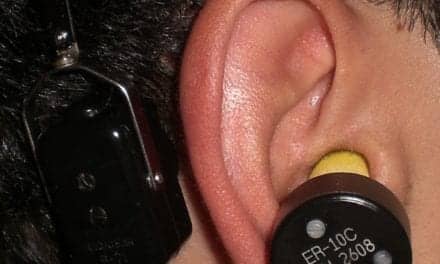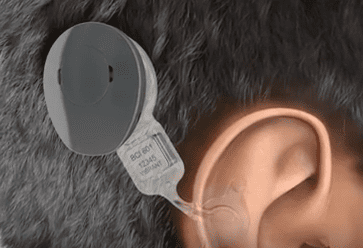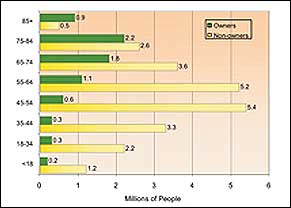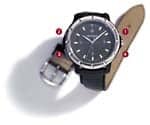Digital shell manufacturing and digital imaging of the ear canal hold excellent promise for improving the fitting process. However, these technologies will be limited by the same factors that currently limit the success of the more traditional impression-taking technologies: asymmetrical ears, the dynamic ear canal, and current impression-taking techniques. This study shows that a patient’s ears are symmetrical relative to being soft or firm (mobile or fixed) only 38% of the time. About 20% of all ears are mobile or soft (which also roughly corresponds to the the overall ITE return rate), but it’s very unlikely that a dispensing professional can recognize a soft/mobile ear through casual observation. Employing the open-mouth ear impression technique and using higher-viscosity impression material would radically reduce return rates.
Feedback is one of the most difficult problems to overcome when fitting a person with a severe or profound hearing loss. This problem is not new and has been with us since the commercial introduction of portable, electronic hearing aids in the 1930s.
Audible oscillation in a hearing instrument, also known as acoustic feedback, occurs when a portion of the output signal from the receiver radiates back to the microphone. If the radiation occurs through a vent, the feedback may be controlled by plugging the vent or reducing its size. However, in most cases, the radiation occurs around the earmold, which provides unintentional, uncontrolled, and inconsistent venting conditions.
Earmold labs constantly look for new materials and technologies that would increase the accuracy of the earpiece fit in the patient’s ear and prevent the occurrence of acoustic feedback. This research is not without its challenges.
The Acrylic Mold
Hard acrylic earmolds derived from ear impressions were a major technological advancement when introduced in the 1940s. Custom made, these earmolds were supposed to provide a satisfactory acoustic seal because they carried all the unique features of the patient’s ear. In reality, acrylic molds did not perform as expected. A 1972 survey of 393 earmolds revealed that more than half of the patients requiring 60 dB gain were unable to enjoy the levels of amplification they required because of ill-fitting molds.1 A review done several years later found excellent mold fittings in some individual areas but the review was generally pessimistic. Nolan2 observed in a study of 45 earmold fittings that higher gain before feedback could be obtained by applying a layer of a build-up material on the earmold. However, attempts to manufacture tighter earmolds for all patients proved impractical; too many earmolds were returned because they were uncomfortable for the user.
The Vinyl Mold
The future began to look more promising with the introduction of vinyl earmolds in the late 1970s. These new softer earmolds were regarded to have the potential to maintain an effective seal for active ear canals, provide greater comfort, and allow higher output levels. To encourage their customers to use this new product, earmold labs offered a guarantee against feedback for 90 days. This new hope for better fittings was reflected in Dawson’s article3 entitled “Earmould production in vinyl—the end of feedback.” The reality proved to be different. An investigation found that vinyl earmolds were effective in 52% of the cases, and were superceded in performance by the acrylic molds in 42% of the cases. In the remaining 6%, the vinyl and the acrylic earmolds performed identically.1
To improve the situation, earmold labs attempted to use modified vinyl that expanded under body temperature and provided a tight seal in the ear canal within minutes. While some patients benefited from this invention, many reported excessive tightness, and the project was terminated. Obviously, this did not stop research for materials that would provide both adequate seal and comfort.
The Silicone Mold
Silicone molds, which appeared in the 1980s, were immediately hailed as the panacea for all fitting issues. Earmold labs advertised that the silicone mold provides maximum comfort and feedback control; it is excellent for all losses and for ears with excessive mandibular movement or sensitivity to pressure.
Practical clinical experience with the fittings quickly revealed that silicone molds were unable to eradicate acoustic feedback, loose fit, and comfort issues from the list of failures due to earmolds. While many dispensing professionals regard silicone earmolds as indispensable, many others use hard acrylic molds just as successfully.
A study4 investigating whether dispensing professionals fit soft or hard earmolds more successfully found that soft earmolds required 0.6% more remakes than hard earmolds—a finding that was unexpected. Some consolation can be found in the fact that 39% of the soft earmolds in this study were ordered for profound and severe hearing losses, whereas fewer (24%) hard earmolds were ordered for such fittings.
Research designed to establish the underlying causes for poorly fitting earmolds found that even the most experienced technicians could fail to make a properly sealing earmold from an excellent-looking impression, but might also unexpectedly succeed with a poor impression. It was also found that, if several technicians processed replicas of an ear impression, the resulting earmolds looked somewhat different. Typically, the earmolds varied in the length of canal, the extent of impression trimming, and the thickness of wax coating. Inconsistencies in earmold manufacturing surfaced as the likely reason for poorly fitting molds.
The Digital Mold
New hopes for higher manufacturing standards and feedback-free instruments appeared with the introduction of the digital shell-making process in 2001. An advertisement from that time captured that drive for perfection, stating that the inadequate precision associated with using outdated, manual methods of modeling hearing aid shells results in a significant amount of unusable product. Digitally created shells will dramatically reduce the amount of instruments that would have had to be redone in the past, saving you and your customers time and money.
In this new digital shell-making process, a laser scans the impression taken by a dispensing professional. Next, the digital image of the impression appears on a computer screen where it is modeled and altered digitally using specialized software into the final hearing aid shell or an earmold. Finally, a “printer” builds the earpiece from a pool of vinyl powder or light-curing liquid resin.5 These processes of impression duplicating, shell modeling, and printing are done with extreme accuracy. (For a review of the digital shell-making process, see Cortez et al.6)
The first digital shells for hearing aids were built as exact replicas of the impressions. Impression trimming and waxing associated with the traditional technology (and commonly blamed for altering the finished mold shape) were expected to disappear forever. Unfortunately, the clinical fitting results were a surprise to many: the digital earpieces were often difficult to insert into the patient’s ear and uncomfortable. To remedy comfort issues, impression trimming was restored and…acoustic feedback surfaced as a major problem. To combat this, hearing aid shells were made tighter by enlarging the virtual ear impression with a “surface offset”—which is the computer-age equivalent of “good-old waxing.”
Today, the results of digital shell-making technology are still not as good as was first expected. Seeing these mixed results, some hearing aid companies are delaying making digital molds for their customers. It should be emphasized that this isn’t related the technology behind manufacturing digital shells (which is good); rather they fear that poor ear impressions taken by dispensing professionals compromise the fitting of digital shells.
Projects have been undertaken to design a device that would take a direct scan of the patient’s ear canal and email the complete and undistorted image of the ear directly to the earmold lab. This image would then be processed with specialized software. In this approach, there would be no impressions with short canals, voids, wrinkles, etc. The idea is that the “perfect ear image” would yield a perfectly fitting earpiece. This, many contend, would be the end of acoustic feedback.
Digital Imaging Would End Acoustic Feedback…Or Would It?
The current situation is that well-established earmold labs experience a similar rate of returns. Commonly, remakes constitute 20% of all custom in-the-ear hearing instruments.7 This situation has not changed for over a decade. With the recent challenges in implementing digital shell-making technology, field consultants anticipate that this level of returns may not be decreased in the near future.
However, in the authors’ opinion, the potential for reducing hearing aid remakes is greater than commonly thought. In fact, the hearing care field already has all the necessary materials, techniques, and technologies to eliminate most of the rework.8-10 We only have to use these resources more effectively and consistently.
Digital shell-making technology and digital ear imaging have great potential. However, even digital ear imaging has its limitations in reducing return rates—just as our current technology has its limitations—if the dynamics of the ear canal are not considered.
Why Digital Imaging Benefits Would Be Irrelevant Unless We Account for the Dynamic Ear Canal
Figure 1 shows the distribution of hearing aid remakes and repairs from the time instruments were issued to the time they were returned to the manufacturer. This data was compiled during research assignments by experienced audiologists pursuing their AuD degrees at the PCO School of Audiology (Philadelphia, Pa, Summer 2000-Fall 2003). The data show uniformity in both remakes and repairs from the second quarter to the end of the fifth year of instrument use. However, the volume of remakes within the first 12 weeks accounts for over half (55%) of all returns within 5 years. This is difficult to justify if we consider that these earpieces are manufactured from ear impressions taken individually from patients’ ears. Intuitively, one would think that patients’ satisfaction and enjoyment with new hearing instruments should be the best upon the onset of hearing aid use, not the worst.
Figure 1. Comparison of remakes and repairs in custom hearing aids.
Evidence points to the potential to lower the volume of hearing aid remakes in the first quarter from 55% to 20%—or even 15%. The impact of such a reduction on customer satisfaction would be enormous. Additionally, the manufacturing cost of hearing aids would be significantly reduced with a reduction in return rates, and these savings could be passed along to consumers in the form of lower hearing aid prices. To accomplish this, the root causes for fitting failures at the beginning of hearing aid service need to be established.
Analyzing Binaural Fittings. Recent studies on remakes occurring for binaural hearing aid fittings provide an interesting insight into the nature of the remakes. Binaural earmolds are interesting to analyze because they are made from ear impressions taken at the same time, from the same patient, with the same material/technique, and by the same clinician. At the lab, the same technician will use these impressions to make shells, and then case and finish the aids. This simultaneous processing eliminates many variations that occur in monaural fittings where impressions are taken from different subjects, on different occasions, and the aids are manufactured by different labs and technicians. Based on this parallel processing, one might assume that, if one aid in a binaural fitting requires a remake, the other would also require a remake—most likely for the same reason. In other words, in binaural fittings, one would expect that binaural remakes should be the most common.
Using data from practicing audiologists enrolled in the PCO School of Audiology AuD program, the authors investigated 337 binaural fittings where one or both instruments required a remake. The patients had similar hearing losses in both ears, and the aids were built with consecutive serial numbers. The results showed that the returns were almost equally divided between binaural, right ear, and left ear remakes. In fact, binaural remakes were the least common, accounting for only for 32% of the returns. Remakes for left ears accounted for 35% of the returns; and remakes for the right ears accounted for 33%.
Surprising Patterns in Digital Shell-Making Returns. A similar pattern in remakes also emerged unexpectedly in digital shell manufacturing: The number of binaural hearing aid fittings is not reflected by the number of binaural remakes. While binaural orders are common for new aids, remakes are typically for only one aid. Obviously, this is not because binaural aids fit better; it is because a remake is usually required for only one aid in the pair.
Figure 2 shows a digital modeling of two hearing aids done with 3Shape software.5 Great care was taken in the shell design. Soon after fitting, one aid was returned due to feedback problems. How could that be? The ears appeared symmetrical, both impressions were satisfactory, and the aids were modeled like twins!
Figure 2. Digital modeling of impressions for the manufacturing of hearing aid shells. Courtesy of 3Shape A/S.5
The reason for the remake was that the impressions were taken with a soft silicone while the patient’s mouth was relaxed (closed). This impression technique was inappropriate for this particular patient. In this case, his right ear was firm, whereas his left ear was softer and had an active ear canal. Not surprisingly, the left aid failed relative to acoustic feedback.
Explanation: Human Ears Are Asymmetrical
The asymmetry in the anatomical structures of human ears should be viewed as a factor leading to early hearing aid remakes. A total of 273 pairs of ears seen in the practices of PCO School of Audiology AuD candidates were evaluated by examining measuring ear impressions taken with light and viscous impression materials, and the subjects’ mouth closed and open (a total of 2182 impressions and over 6,500 measurements). The results indicate that only 38% of those pairs of ears could be considered symmetrical. Close to two-thirds (62%) of the pairs of ears exhibited varying degrees of asymmetry.
It was found that, for some subjects, one ear was firm and not active while the other ear was soft and severely affected by mandibular movement. In fact, the variances in ear tissue softness and mandibular movement between the two ears of one subject were as great as variances found among ears of different subjects. These results are consistent with data obtained in previous studies.11,12
The fact that over 60% of patients have asymmetrical ears corresponds surprisingly well with the fact that over 60% of remakes occurring in binaural fittings are for one aid only. Since a loose fit and feedback are the dominant problems in hearing aid remakes, it is reasonable to conclude that the majority of ear impressions taken by dispensing professionals do not adequately capture the ear softness and the magnitude of mandibular movement.
Another pair of factors that match is that approximately 80% of human ears are firm and not affected by mandibular movements,9 and that 80% of hearing aids do not require a remake.7
This implies that the 20% of ear canals that are soft and/or mobile should be recognized as such prior to impression taking. To lower the risk of fitting problems, impressions from such ears should be made with a firmer (higher) viscosity silicone and with the patient’s mouth wide open (see sidebar).13-14 This is not required for the remaining 80% of ears because impressions from firm and inactive ear canals can be taken with any impression material and any technique, and the resulting hearing aids will (almost) always fit well.
The problem is that dispensing professionals are only able to successfully detect high-risk ears with a relatively low (25% to 46%) accuracy rate.9 In fact, many of the experienced audiologists evaluating the effects of altering the impression technique were surprised that they were unable to predict the changes in impression size and shape when examining patients’ ears.6
The Only Way to Go. This lack of precise assessment means that all ear impressions can and should be taken as higher-viscosity open-mouth molds. The common employment of this approach has the potential to eliminate more than a half of remakes in new hearing aids and significantly elevate patients’ satisfaction with their instruments.15-17
| Open-Mouth Impressions
An open-mouth impression is an imprint of the patient’s ear made with his or her mouth wide open. This technique does not include any jaw or head movements. Because having the mouth open for the whole process of impression taking is difficult for the patient, using a prop is recommended. The mouth prop is to be placed between the molars, on the side the impression is made. This should be done before the impression material is mixed. Because some patients may drool, offer them paper tissue (eg, Kleenex) in advance. Mix and syringe the material into the ear following standard procedures and precautions. Let the mold cure undisturbed. When finished, remove the mouth prop. Then loosen the impression, and take it out. If an impression from the other ear is required, use another prop and take the second impression in the same manner. If you are ordering a hearing instrument with a long canal, request that the lab technician taper the end of the canal in the impression to prevent insertion and discomfort problems. |
Summary
Recent research indicates that the reason for many unsuccessful custom hearing instrument fittings appears to be inadequate ear impressions—and not the limitations of the in-lab impression processing. Dispensing professionals should be aware that complete and full ear impressions taken with a light silicone and the patient’s mouth closed are often inadequate for manufacturing effectively sealing and comfortable earpieces.
In this light, it can be seen that digital shell-making technology—while extremely helpful and efficient—will also suffer from many of the same limitations that our traditional shell-making technologies have relative to the elimination of acoustic feedback. Whatever the technology, for the best fitting results, clinicians should modify their impression technique and routinely take open-mouth impressions with a firmer silicone for all hearing instruments.
When this is accomplished, the end of acoustic feedback will be much nearer.
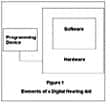

|
Correspondence can be addressed Chester Pirzanski, Starkey Labs Canada, 7310 Rapistan Ct., Mississauga, Ontario, L5N 6L8, Canada; email: [email protected].
References
1. Huntington A. How near is the end of feedback? J Brit Assn Teachers of Deaf. 1979; (3) 4:123-12.
2. Nolan M. A simple method of improving the acoustic seal of an ear mold. J Brit Assn Teachers of Deaf. 1979; (3) 4:123-127
3. Dawson F. Earmold production in vinyl – The end of feedback! J Brit Assn Teachers of Deaf. 1977 (1) 2:74-77
4. Pirzanski, C. Earmold acoustics and technology. In: Sandlin R, McCandless G, eds. Textbook of Hearing Aid Amplification. San Diego: Singular Publishing Group; 2000:137-169
5. 3Shape A/S. Available at: www.3Shape.com. Copenhagen, Denmark: 3Shape A/S. Accessed March 16, 2004.
6. Cortez R, Dinulescu N, Skafte K, Olson B, Keenan D, Kuk F. Changing with the times: Applying digital technology to hearing aid shell manufacturing. Hearing Review 2004; 11(3):30-38.
7. Kolpe V, Oliveira R. Chemistry and rheology of otoplastic materials. Sem Hear. 2003; 24(4):289-298
8. Pirzanski C. Ear Impressions for the new laser shell technology. Sem Hear. 2003: 24(4): 323-332
9. Pirzanski C, Berge B. Earmold impressions: Does it matter how they are taken? Hearing Review. 2003; 10(4):18-20,80. Available at: www.hearingreview.com/Articles.ASP?articleid=H0304F01.
10. Pirzanski C. Factors in earmold style selection: Starting (and finishing) right. Hearing Review. 2001; 8(4):20,22,24. Available at: www.hearingreview.com/ Articles.ASP?articleid=H0104F01
11. Oliveira R. The dynamic ear canal. In Ballachanda BB, ed. The Human Ear Canal. San Diego: Singular Publishing Group Inc; 1997: 83-111
12. Pirzanski C, Berge B. If you blame buffing for fitting problems, you’ve probably got the wrong impression. Hear Jour. 2004, 57
13. Pirzanski C. An alternative impression-taking technique: The open-jaw impression. Hear Jour. 1996; 49(11):30,32,34,35.
14. Pirzanski C. Anatomically accurate ear impressions. Audecibel. 1999; 1-2;9-11
15. Pirzanski C. Issues in earmold fitting and troubleshooting. Sem Hear. 2003:24(4):355-363.
16. Pirzanski C, Berge B. An ear impression technique that works! Hearing Review. 2002:9(12): 24-27,53. Available at: www.hearingreview.com/Articles.ASP?articleid=H0212F02.
17. Pirzanski C, Berge B. Ear impressions: Art or science? Audiology Online. Available at: http://www.audiologyonline.com. Accessed: March 18, 2002.

.gif)
.gif)
.gif)
.jpg)
